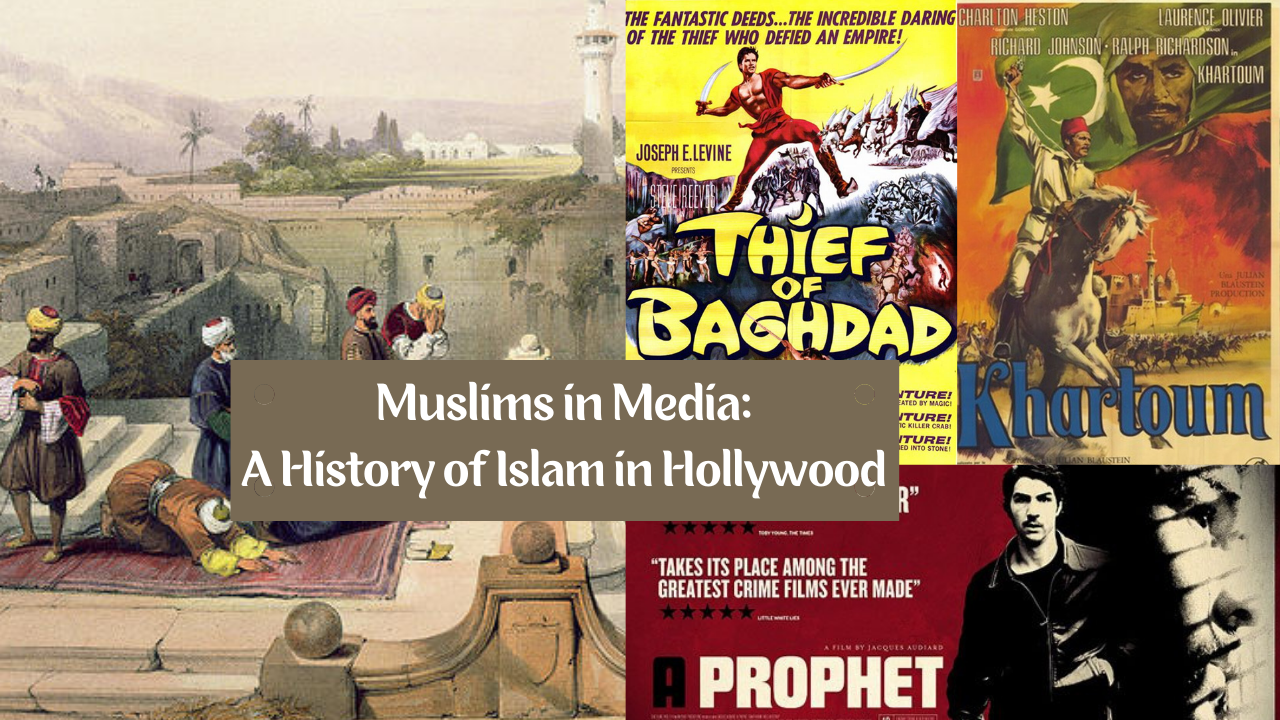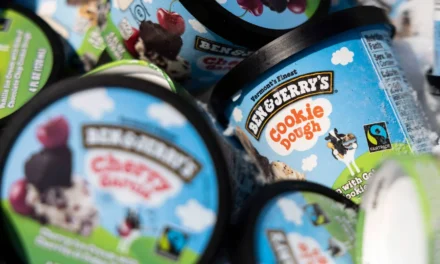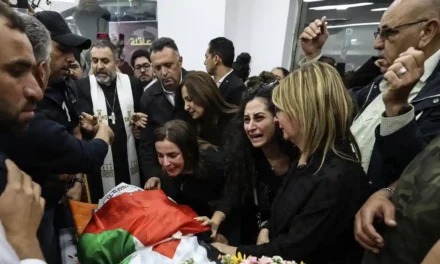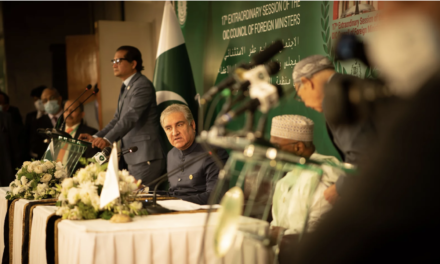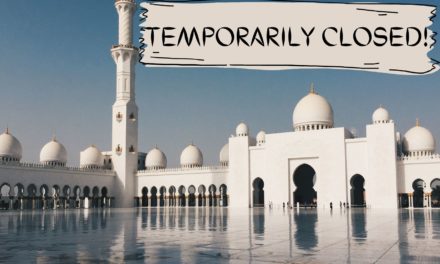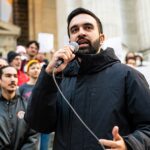Like so many of my generation, I was ‘raised’ in a sense by TV and movies, from watching Jackie Chan and Jim Carrey as a child to my adolescence filled with the Hard R action of John Woo and Tarantino to my adulthood in which films have become akin to a sacred or spiritual experience. I consider the great masters like Martin Scorcese, David Lynch, Akira Kurosawa, Terrence Mallick, Aamir Khan, and Paul Thomas Anderson (too many to name!) to be teachers in a sense providing glimpses into the realities and lives of characters so foreign, yet so remarkably similar to myself.
The series below outlines the chronological development of Islam and Muslims through the ‘lens’ of Hollywood. I showcase certain films which serve as microcosmic examples of wider sociopolitical, religious and cultural considerations in the past 100 years. What changes have we seen in how Muslims are portrayed, and what are the practical implications of this? We delve into research to uncover the link between media representations and support for public policy, such as military action against Muslims. Finally, I illustrate how Hollywood can embrace a deeper sense of ‘diversity’ by exploring the existential, mystical, spiritual and inspiring aspects of Islam.
Cinema From the 1930s to 1970s
Part 1 delves into the ‘golden age’ of Hollywood and how the depiction of Muslims/Islam had an Orientalist bent due to Western nations still having tremendous sociopolitical hegemony over Islamic nations. Films such as ‘Arabian Nights’ and ‘Thief of Baghdad’ showcase Islamic or Middle-Eastern culture as ‘exotic’ and ‘otherworldly’ with genies, flying carpets, magic lamps and swashbuckling hero’s as main fixtures of the story. Muslims or Arabs are largely not portrayed in these films as white actors put on ‘dress-up’ in large-scale Hollywood productions such as ‘Cleopatra’. A movement toward realism in cinema during the 50s and 60s also impacted the grand spectacle ‘adventure’ genre, as exemplified in ‘Lawrence of Arabia’ and ‘Khartoum’. These films used real Arab or Muslim actors and filmed in Islamic countries, showcasing historical events, namely the Arab Revolt against the Ottomans during World War I and the 1885 siege of Khartoum by Muhammad Ahmed (Sudanese leader who proclaimed to be the ‘Mehdi’).
This period gave rise to Mohammad Yachteen, the first Arab-American actor who starred in over 500 pictures.
Cinema From the 1980s to 1990s
Part 2 delves into the 80s/90s decades of cinema, which took elements of realism and blended them with action-thrillers such as in ‘True Lies’ and ‘Executive Decision’. These films took political issues such as domestic terrorism, Arab nationalism and the rise of globalization with a ‘superhero’ everyman such as Arnold Schwarzenegger, ultimately saving the day. Post-colonial strife with Islamic countries, such as the rise of the Palestinian Liberation Organization and the Iranian Revolution, necessitated villains for American audiences to root against. ‘Rambo III’ is highlighted as a unique example in which the Mujahadeen or Taliban are portrayed as ‘good guys’ to aid in the defeat of the Soviets. These films were reflections of U.S. foreign policy relations and the U.S military-industrial complex. Almost a decade later, we saw media lampooning this idea of America being the morally righteous vindicator of the world, such as in ‘Team America: World Police’.
Cinema in the 2000s (post 9/11)
Part 3 delves into the post-9/11 period, which saw a recontextualization of the complex geopolitical tension with the Middle East. Films such as ‘Syriana’, ‘Body of Lies’, ‘the Kingdom’ and ‘Traitor’ portray the ‘War on Terror’ as a disorienting quagmire of bureaucratic negligence and confusion. ‘Traitor’ for example, showcases Don Cheadle as a devout Muslim who is working under deep cover for the FBI but begins having doubts as to whether his actions are morally justifiable. The film ends with a Quranic quote:
Because of that, We decreed upon the Children of Israel that whoever kills a soul unless for a soul or for corruption [done] in the land – it is as if he had slain mankind entirely. And whoever saves one – it is as if he had saved mankind entirely.”
[5:32]
Although Muslims were no longer portrayed as single-dimensional fundamentalists, these films reflected a U.S. governmental stance towards advocating a ‘humane’ war in the Middle East. Hence, a film such as ‘Iron Man’ showcases a clear delineation between ‘good Muslims’ who are meant to be saved and ‘bad Muslims’ who are reigned down upon by missiles and drones with no judicial process. How can his Jarvis technology accurately identify who is ‘bad’ and who is ‘good’? Well, in the case of the U.S. military, the means usually do justify the ends.
I highlight research linking the military-industrial complex with media conglomerates which incentive ‘positive portrayals’ for the usage of equipment and personnel: (I use ‘Untouchable’ as an example of a film that was passed over by most production companies and released only on DVD, which demonstrates that most times ‘the ends does not justify the means’).
I also touch on research relating negative portrayals of minorities to public policy efforts such as harsher sentencing and support for military action (and conversely, how positive portrayals are able to reduce prejudice & increase equitable treatment), as well as how a new age of war (drone strikes) is causing a tremendous rise of PTSD in military personnel.
Part 4 delves deeper into the background psychology, which necessitates audiences needing ‘bad guys’ to root against. Where does this innate tendency come from? I zero in on the ‘in-group bias’ using clips in which other non-Muslim groups have been antagonists, such as the Vietnamese during the U.S. involvement in Vietnam and Eastern Europeans during the Cold War (and why that still isn’t okay). I also relate the research on how positive portrayals of minority groups through exposure to the cinema can reduce implicit bias and what practical effect this has on our judicial system. Lastly, I speak on integrating spiritual/mindful tools to reduce prejudice, even for Muslims, as many of our biases are driven by unconscious heuristics or ‘mental shortcuts’. Here’s more information.
Media in the Diversity Era (Present)
Part 5 delves into ‘diversity-era’ Hollywood and strides made to represent Muslims (or at least American-Muslims) in an equitable manner. Media such as ‘the Big Sick’, ‘Ramy’ and ‘Master of None’ showcase our human sides so that mainstream audiences are now able to connect with our cultural disparities and religious strife with being Western and Muslim. I illustrate how this new trope of the ‘confused Western Muslim’ can itself be as unidimensional as the ‘fundamentalist terrorist’. I speak more broadly on why Hollywood does such a poor job of portraying faith, as noted here on the representation of Catholics/Christians.
I touch on the works of Terrance Malick and Martin Scorsese, who utilize faith and religion in a deeper, existential manner so that characters are richer and more complex. Faith itself isn’t always to be poked at and made fun of, but rather the fallible nature of humans and our tendency to self-damage and cause psychic wounds. I use a beautiful clip from the Season 1 Finale of ‘Ramy’ which states a hadith from the Prophet (pbuh): :I swear by Allah that you do not enter paradise until you believe, and you do not believe until you love one another…”
Favorite Portrayals of Islam/Muslims in Hollywood
Part 6-8 delves into portrayals of Muslims/Islam from all periods in Hollywood, which I feel come the closest to depicting the socially conscious, spiritual, transcendent and illuminating aspects of our faith.
I delve into each one fully, beginning with ‘Malcom X’ and how the figure of El-Hajj Malik Shabazz looms large in the collective conscious of the American Muslim. Spike Lee’s 1993 biographical picture with Denzel Washington’s Oscar-nominated role begins with ‘Red’ as a streetwise pimp who is imprisoned and seeks to uncover the truth, the film culminates in a beautiful montage of Malcolm visiting the Islamic world and completing Hajj. Denzel, as Malcolm X, reads Surah Fathia (‘The Opening’) in its entirety in the Hagia Sofia in Istanbul, Turkey. His presence continues to inspire us in entrenching a socially conscious element to Islam which challenges the status quo and equips believers to remember:
You resort to oaths as instruments of mutual deceit so that one people might take greater advantage than another although Allah puts you to the test through this. Surely on the Day of Resurrection He will make clear the truth concerning the matters over which you differed.”
[16:92]
‘Three Kings’, directed by David O. Russell and released in 1999 starring George Clooney, Ice Cube, and Mark Wahlberg is the 2nd film which I include as it portrays the Gulf War from the perspective of Shia Muslims who were impacted by the Baathist oppression of Saddam. This is a politically incorrect, action-war thriller which pulls no punches, it does not seek to showcase the U.S. military as ‘holier-than thou’ exemplars but as corrupt individuals who are swayed to find hidden bullions of gold. But through the course of their own materialistic reckoning, they find that they want to help these dissidents cross over to the Iranian border. They absolve their own greed to sacrifice for others. I include a beautiful scene of Ice Cube kneeling as he prays Salaat al-Mayaat alongside Shias and is told about the sacred shrine of Imam Hussain.
‘The Message’ is a 1976 epic directed by Moustapha Akkad, filmed in both Arabic and English. I, alongside many other Muslim youth, used to watch this 3 hour+ epic in my Sunday school as it showcases the early years of Islam from the initial revelations to the Holy Prophet, the Hijra or pilgrimage to Medina to escape persecution and battles with Paganist tribes. Akkad, a devout Muslim, sought consultation from numerous Islamic clerics to accurately depict these events and was inspired to make the film to help Western audiences understand that Islam was a natural continuation of the Judeo-Christian intellectual tradition.
‘The Prince of Egypt’ released by DreamWorks in 1998 is another personal favorite which I used to watch as a youth in Islamic Sunday School. It uses animation, song and drama to depict the story of Moses so that millions are inspired, regardless of background or faith affiliation. Moses can easily inherit riches as his adopted brother Ramses is heir to the throne, but he seeks to uncover the truth and flees, being present to the divine manifestation of Allah and freeing the Hebrews, leading them out of Egypt as a Prophet of Allah. This is a ‘religious’ film in all the right ways. It is not condemning to others and uses the figure of Moses to depict what it means to persevere and stand with righteousness.
O Moses! I have chosen you over people for messages and words, so take what I have given you and be among the thankful.”
[7:144]
My last part includes ‘A Prophet’ (French film released in 2009 about a Moroccan prisoner seeking to find redemption and survival), ‘Mogul Mowgli’ (2020 film starring Riz Ahmed about a Pakistani-British rapper who has an autoimmune disease, showcases the Partition of 1947), and ‘A Night Of’ (2016 HBO series about a Pakistani-American who is imprisoned for a crime he did not commit and must metamorphize to survive). I also include ‘Lost’ which had Andrew Naveen play Sayyid Jarrah as an Iraqi prison guard, a fan favorite with elements of his Muslim identity being used to showcase his nobility and steadfastness as a character. I include these examples to illustrate that religion and faith can be secondary or tertiary elements to a plot or a character’s arch. They do not always have to be front and center as the variable to be inspected and ridiculed or praised. Muslims, just like anyone else, are dynamic and multi-layered individuals with competing social, financial, emotional, psychological and spiritual profiles.
Let us know some of your favorite depictions of Muslims and Islam on the silver screen and how cinema can better represent our faith!
Bibliography
- Comprehensive USC study on Muslim representation in media
- Muslims are a growing presence in the U.S. but still face negative views from the public
- Ahmed, S., & Matthes, J. (2017). Media representation of Muslims and Islam from 2000 to 2015: A meta-analysis. International communication gazette, 79(3), 219-244.
- Brewer, M. B. (2007). The social psychology of intergroup relations: Social categorization, ingroup bias, and outgroup prejudice.
- Saleem, M., Prot, S., Anderson, C. A., & Lemieux, A. F. (2017). Exposure to Muslims in media and support for public policies harming Muslims. Communication Research, 44(6), 841-869.
By Syed Rizvi
